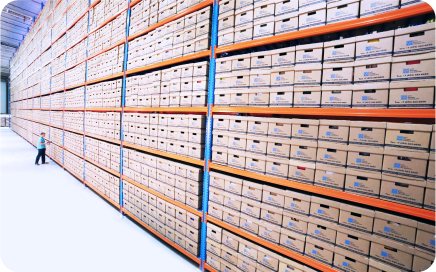How to Optimize Your Warehouse Layout as You Grow
By Rackbeat August 7, 2025

When your business is growing, it’s usually a positive sign. More orders are coming in, and your product range may be expanding. But growth also brings new demands—especially on your warehouse layout and overall warehouse management. If your setup doesn’t evolve with your business, you may experience bottlenecks in order management, space shortages, and inefficient use of time and technology.
An effective warehouse layout isn’t just about shelves and floor space—it’s about creating flow, minimizing wasted time, and ensuring that your staff can work quickly and accurately. This requires continuous adjustments, insights into purchasing management, and ideally, support from a modern WMS along with the right warehouse hardware like barcode scanners and automated storage solutions.
In this article, we’ll guide you through how to:
- Identify signs that your layout is outdated
- Map and analyze your current workflows
- Set up your warehouse using ABC analysis and clear zones
- Support growth with technology, WMS, and warehouse hardware
- Make layout optimization a consistent, value-creating routine
Why Your Warehouse Layout Is Crucial for Growth
Your warehouse layout forms the backbone of all daily operations—from goods reception to picking and packing. The more intuitive and streamlined it is, the faster and more efficiently your employees can work. A well-designed layout cuts down transport time, reduces confusion and errors—and this has a direct impact on your bottom line.
But as you grow, weaknesses in your layout quickly become apparent. New products demand more space. More employees need to move around at the same time. Pick routes get longer and more chaotic. If you don’t make changes in time, you risk inefficiency, delays—and ultimately, unhappy customers.
An updated warehouse layout isn’t just a practical necessity. It’s a strategic tool to support your growth and increase capacity without expanding your square footage. With proper inventory management and the right warehouse hardware, you can make far better use of your existing space.
Signs It’s Time to Update Your Layout
Your warehouse often gives you clear signals when it’s time for a layout change. Here are some of the common signs that your current setup no longer meets your needs:
- Long pick routes: Employees spend too much time walking back and forth to find items.
- Bottlenecks in processes: Congestion occurs at packing stations, printers, or loading docks.
- Disorganized storage: It’s difficult to locate specific items, especially for new staff.
- More picking errors and incorrect shipments: Lack of overview leads to costly mistakes.
- Space constraints: There’s no longer room for new products, or returns pile up.
- Technology and workflows don’t match: For example, you’ve added barcode scanners or other warehouse hardware that haven’t been incorporated into the layout.
The more of these symptoms you recognize, the stronger the case for rethinking your layout. A well-functioning WMS can help identify these issues early.
5 Steps to a Smarter Warehouse Layout
1. Map Your Current Workflow
Before making any changes, you need to understand how things currently operate. Start by analyzing the entire goods flow—from reception to packing and shipping. Note where delays, duplicate work, or unnecessary movements occur.
Use data from your WMS or warehouse management system, and consider walking through the warehouse with an employee to observe where picking and order management are disrupted. This is often where small changes can yield big improvements.
2. Organize Stock Using ABC Analysis
A simple way to optimize your layout is by applying the ABC method:
- A-items: Fast movers. These should be placed closest to packing stations.
- B-items: Medium turnover. These go in the middle of the warehouse.
- C-items: Slow movers or seasonal goods. These can be stored further away or higher up.
By prioritizing based on turnover rate, you can significantly reduce walking time and improve order management efficiency.
3. Create Clear and Logical Zones
Think of your warehouse as a production line with clearly defined zones:
- Goods reception and inspection
- Buffer or bulk storage
- Picking and packing
- Returns processing
- Outbound shipping
A systematic layout with clear zones supports better purchasing management, easier onboarding for new staff, and fewer everyday mistakes. It’s also a huge benefit if you’re using warehouse hardware that requires specific workstations or power sources.
4. Ensure Clear Signage and Structure
Even the best layout won’t help if it’s hard to navigate. Use clear signage for shelving and zones, floor markings, and standardized labeling. This makes it easier for new staff to get started—and saves time for everyone.
Consider using visual guides or wall charts that show picking routes, item groups, and layout overviews. Here, your WMS can play a major role by generating dynamic maps or updating locations automatically.
5. Use Technology to Drive Optimization
A modern WMS (Warehouse Management System) is key to keeping your warehouse layout data-driven and up to date. It helps you:
- Identify top-selling items and their ideal storage locations
- Generate efficient picking routes using real-time data
- Digitally manage multiple locations and zones
- Optimize both order and purchasing management
- Get the most out of your warehouse hardware
As your business grows, aligning your layout with technology becomes increasingly important.
Make Layout Optimization a Regular Practice
Warehouse layout isn’t a “set it and forget it” task. Reality changes constantly: new products, seasonal fluctuations, promotions, staff changes, and tech upgrades. That’s why layout reviews should be scheduled at least quarterly.
Small, ongoing adjustments—based on WMS data and team input—can lead to major efficiency gains. The more integrated your warehouse, order, and purchasing management become, the easier it is to scale without compromising flow and quality.
Get More Tips in Your Inbox
Want more hands-on advice on how to optimize your layout, choose the right warehouse hardware, and use your WMS more effectively?
Sign up for the Rackbeat newsletter and get:
- Practical guides and insights on warehouse management and optimization
- Tips for smarter order and purchasing management
- Updates on WMS features and integrations
- Inspiration from other inventory-driven businesses


